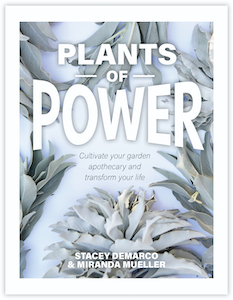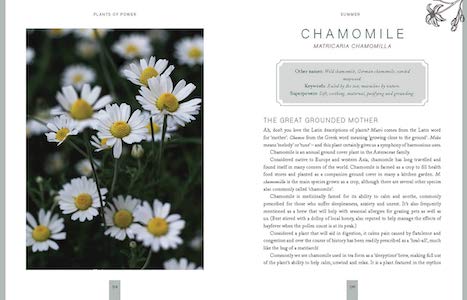
Plants of Power: Cultivate Your Garden Apothecary and Transform Your Life, by Stacey Demarco and Miranda Mueller
Rockpool Publishing, 1925924351, 352 pages, September 2021
“Go touch grass.” This is a sentiment that I really took to heart this past spring, summer, growing season or whatever else you want to call it. I ended up going ham in my little yard and definitely bit off more than I could chew this season. Clearing out the unwanted and planning for what I did want around me was rough and it’s still a work in progress.
It’s through this little foray into the growing stuff side of life that made this book ping my interest radar. So, I waddled over to my shelf just to see what I had over there. Whelp, I will admit I had no books on plants. None, zip, zilch.
I want a practical plant space. I want it full of good strong allies ready and willing to help me out when I need it in exchange for the love and care I have to give. And with a hesitant chuckle, I began to read Plants of Power: Cultivate Your Garden Apothecary and Transform Your Life by Stacey Demarco and Miranda Mueller. This book is a good book, a great book even, and it has definitely taught me a thing or two.
I was aware that our ancestors, those who walked before us, had a deep connection to the land. It fed them, gave them the raw materials needed to build tools and shelter, the power to mend wounds and ease illness, all things we have lost touch with today. They found the plants that lessened swelling and eased a headache by observing what we nowadays can glean from a quick google search provided by science and electricity. This was their science; our science is much different. Don’t get me wrong, science is great, but it is also not so great.
“Talk of how a plant might alter consciousness has increased the chance of that plant being banned by authorities, usually with a campaign of fear.”1
It’s the sad truth. We are so disconnected from the land and how to use it that we fear what should not be feared, we demonize what should be respected and we cherry pick which plants get this treatment. We do not shun the Lily just because it’s lethal to cats. We ignore the fact that the bulb of the Daffodil is bad for both us and our canine companions as we edge walkways with them. There are so many wonderful plant allies that have been done dirty just because we do not understand them the way we once did. I better cut this off here though and move onto the book proper here.

Part One
This book, past the intro, is divided into two main sections. The first part consists of six bite sized charters that covers a little about our authors and some general plant knowledge.
The first chapter is the meet-the-author chapter. Here we get an abridged version of their life paths away and back to the land. The next two cover nature and the land. The patterns that appear in nature have lessons to teach us if only we would slow down and listen, tending the land that we have is a great way to do this by the by. Be this land a full yard or a few pots on a balcony, it’ll do you some good me thinks.
The second half of the chapters are less about the land itself and more about the plants and what we can do for/with them. Did you know that plants can sense your intent? What about the fact that there’s two, two different ways to compost? What about using the moon and zodiac signs in your planting and harvesting? I sure as heck didn’t. I’d recommend paying extra attention to these sections, as they were quite eye opening for me and I’m sure they will also be for you.
Part Two
Here we get into the greenery proper. The plants are split into sections based on season and each plant gets a few pages to itself. These pages are laid out as follows. First, the common name at the top and the scientific one directly underneath it. Then, under that a box is further quick info like other names, planetary rulings, and a little correspondence list. Past the box is a quick blurb on the plant, some notes on its cultivation and foraging.
The really fun part of this section, the crafts section. In the crafts section, we get a bit of a mix bag from recipes for food like mint pesto and even mouthwash to meditations and salves centered on our plant in question.
Y’all my wallet gonna hate me this coming spring! I’m kidding…maybe… But in all seriousness coming out of the reading gauntlet (I tore through this book in three days) I have a deeper appreciation for the earth and the plants that I already have been tending. Which are a few mints, some common sage bushes, rosemary and a marshmallow, in case you were curious. My wishlist of plants has also become obscenely long, but it will be thinned out as I research further on which ones will grow best in my area. I hope to add at least two plants from this book as well as many, many more mint plants in pots so I can make all the mint pesto I want (recipe page 180).

Miscellaneous
I did have some minor issues with this book. Don’t you go scrunching your face up at these words, remember it’s physically impossible to fully please everyone with what you create and you just gotta roll with it. The biggest, most glaring issue is where is the index?! There’s usually an index in books like this. I don’t normally need to use the index, but in looking for the page with that mint pesto recipe, the index was sorely missed. I mean I eventually found it, but it would have been so much faster and less frustrating had there been an index.
These next two wishes were not mine originally. My wonderfully accepting and former chef father pointed out that some of the plants with an edible craft do not have a basic flavor profile. While this particular nit-pick isn’t a big one, it’s still something that might have been nice. The last one is phonetic spelling on some of the names. We spent a good twenty minutes debating the pronunciation of Comfrey over coffee one afternoon. While it was invigorating to whip out my phone and prove myself correct, this particular inclusion would have made the discussion unnecessary.
Overall Plants of Power is a great book, well worth the coin for this particular ware. This book would be a good fit for someone who doesn’t have much knowledge about plants and their real uses beyond being a pretty thing outdoors. As a beginner in the plant world there is so much more to learn but that’s what research is for and this book is a great place to start from.
The basic info provided is enough to get an idea of what you might want to start growing. This would help to keep the budding gardener from becoming overwhelmed by the sheer volume of things out there to learn. Why spend hours learning all the ins and outs of growing say an olive tree if you know for a fact you don’t have the space or proper growing conditions for one?
I would also think someone with an intermediate to advanced knowledge of plants would also find value in Plants of Power. Even if they don’t exactly learn anything “new”, the different perspectives these two authors bring to the table ought to open doors to revelations and breakthroughs that might otherwise have laid dormant.

Antoinette Aird is a lifelong creator of whatever pleases her, thank you very much. Be it short stories that never see the light of day or ramblings on items she loves. When she’s not shouting at the neighbor chickens for pecking at her garden or reading you can find her attempting various methods of divination or trying to befriend the local stray cats. Antoinette has a lot of thoughts floating around in her brain and is willing to share them. Come and sit for a spell…

[…] energies with care. She has created dozens of oracle decks and books, including The Enchanted Moon, Plants of Power, Moon Magick, and The Halloween Oracle. For over 25 years she has shared her gifts as a pagan […]